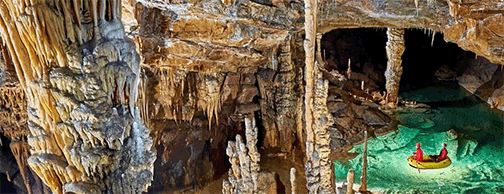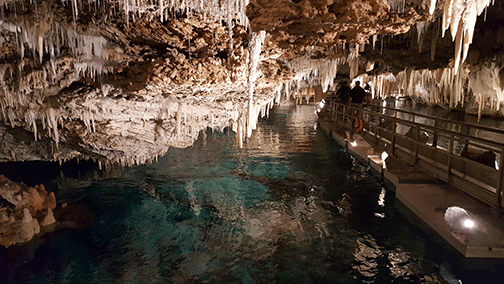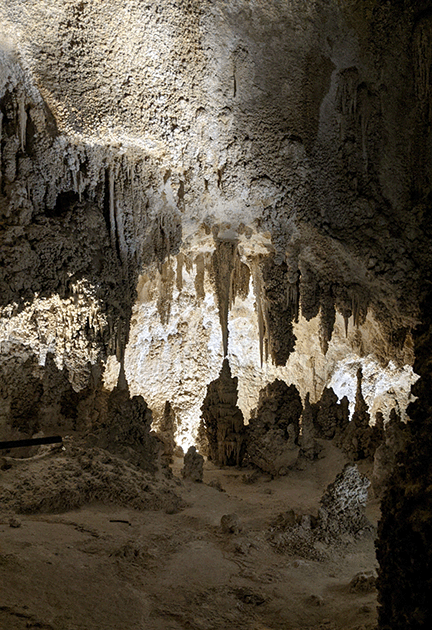NMT Celebrating 2021 as the ‘International Year of Caves and Karst’
February 17, 2021
NMT’s National Cave and Karst Research Institute in Carlsbad organizing events to put natural wonders in the spotlight
SOCORRO, N.M. – New Mexico Tech is putting Earth science on center stage this year for the International Year of Caves and Karst. The special designation will be celebrated with events, podcasts, radio spots, publications and much more.
 Dr. George Veni, the Executive Director of NCKRI, said the International Year of Caves
and Karst is near and dear to many scientists and students at NMT.
Dr. George Veni, the Executive Director of NCKRI, said the International Year of Caves
and Karst is near and dear to many scientists and students at NMT.
"The IYCK is important because it allows us to teach the world what karst is, that caves and karst are valuable to humanity in many ways, but also highly vulnerable to damage and need to be protected,” he said.
 The National Cave and Karst Research Institute, or NCKRI, is an NMT division based
in Carlsbad. The Earth and Environmental Science Department at NMT will participate
and promote the special events throughout the year.
The National Cave and Karst Research Institute, or NCKRI, is an NMT division based
in Carlsbad. The Earth and Environmental Science Department at NMT will participate
and promote the special events throughout the year.
(At right is the Crystal Cave complex in Bermuda.)
Veni said, "We hope this yearlong celebration brings general awareness to this 20 percent of the world that is hidden beneath our feet, but also hidden in plain sight because it is often not recognized."
 Karst is a topography formed from the dissolution of soluble rocks such as limestone,
dolomite, and gypsum. Karst is characterized by underground drainage systems with
sinkholes and caves. Karst landscapes covers about 20 percent of the world’s land
surface and is the sole or main water source for about 700 million people.
Karst is a topography formed from the dissolution of soluble rocks such as limestone,
dolomite, and gypsum. Karst is characterized by underground drainage systems with
sinkholes and caves. Karst landscapes covers about 20 percent of the world’s land
surface and is the sole or main water source for about 700 million people.
As global water resources, caves and karst are important areas of study for our communities and civilization; these formations also represent extreme environments that scientists view as analogs for how life could exist on other planets and moons. NMT has a handful of scientists who study caves, including hydrologists, geologists, and biologists. Assistant professor of geobiology Dr. Daniel Jones is one of those scientists, as well as the Director of NCKRI’s Academic Program.
(At right is a scene from Carlsbad Caverns National Park.)
“Cave and karst science impacts everyone, whether they know it or not,” Jones said. “Caves and karst provide important mineral and other natural resources, and about a tenth of the world’s population gets water from aquifers in limestone and other karst rocks.”
On the surface, karst takes many forms, which makes it difficult for the average person to recognize. Some are dramatic and scenic.
Much of karst landscapes are also hidden from view in caves. Caves and karst are priceless resources. Hundreds of caves are open to tourism around the world, many in World Heritage sites.
More than 150 million tourists visit caves each year, providing vital support to many national economies. Karst aquifers include the largest wells and springs on Earth. Caves and karst are home to many of the planet’s most diverse, important, and rare ecosystems, supporting ecological diversity above and below the ground.
The world’s most significant cultural and archaeological sites often are found in karstic and non-karstic caves. While caves and karst benefit all societies, they also present some unique challenges. The caves and related conduits of karst aquifers offer essentially no filtration of pollutants.
“Caves are excellent tourist and recreational features, but they are also great sources of science and discovery,” Jones said. “The IYCK will generate interest in the diversity of scientific fields that rely on caves, from hydrology and natural resource science, to archaeology and paleoclimatology, to microbiology and even astrobiology."
Karst aquifers are the most complex, least understood, most difficult to model, and most-easy to contaminate groundwater supplies. They are often able to rapidly transmit pathogens and chemicals tens of kilometers undetected to vital human and ecological water sources. As often hidden features and landscapes, caves and karst are generally poorly understood. Few scientists and natural resource managers are adequately trained to properly study or manage them.
The International Year of Cave and Karst, is an initiative of the International Union of Speleology, or UIS. The UIS is a non-profit organization, headquartered in Slovenia, dedicated to the exploration, study, and proper management of caves through international cooperation.
The UIS is comprised of 55 member nations which support the International Year of Caves and Karst. The UIS hosts an International Congress of Speleology every four years, which is the world’s most significant gathering of cave and karst scientists, managers, educators, and explorers. Dr. Veni is the current president of the UIS.
The 18th International Congress of Speleology will be held in Savoie-Technolac, Le Bourget du Lac, Savoie, France in July 2021. The conference will be expanded into the major international event that will celebrate the International Year of Caves and Karst. Many other scientific and educational events for the International Year will be organized.
The long and growing list of events is at: www.iyck2021.org. In addition to the work of the UIS member nations, the International Year of Caves and Karst is supported by about 130 of international and national organizations. All supporting organizations are also listed on www.iyck2021.org.
– NMT --